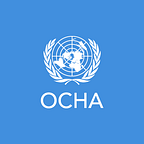A film crew’s journey to South Sudan
The world’s newest country is also the scene of one of today’s worst humanitarian crises. Recently, a UN film crew traveled to a remote part of the country to witness the daily reality of thousands of displaced people and how aid groups are striving to alleviate their suffering.
By David Gough and Thomas Maddens, UN Office for the Coordination of Humanitarian Affairs (OCHA)
At first sight, this place looks much like anywhere else along the East African equator. The soil is dry and dusty, and barely anything grows without the protection of thorns. There are no schools, few houses, and livestock are few and far between. It is eerily quiet.
But when night falls, when the fierce heat of day abates and the wind slows to little more than a rustle, the vast sea of humanity that is sheltering here reveals itself by sound, not sight. At first it sounds like little more than a murmur, but soon the murmur becomes a buzz that increases in intensity until it is almost a cacophony of sound.
Here in Wai, among the shifting sands of South Sudan’s increasingly bitter civil conflict, thousands of people have sought refuge from the fighting in nearby towns and cities. They are the ones who suffer in a long power struggle which broke into violence in December 2013 with catastrophic consequences for millions of people across the country. A struggle which continues to sow violence and threaten civilians.
Last month, we traveled to Wai to see how people trapped by this conflict are surviving, and to gauge the response of the humanitarian operation that has been set up to assist them. We were able to document on film the reality of their daily struggles.
Sadly, the conditions we found in Wai are playing out in remote communities across the country.
Aid experts in South Sudan say that 4.1 million people are to be assisted in 2015. To finance this support, they have appealed to Governments and other donors for US$1.8 billion. It’s a huge sum of money, but for people in places such as Wai, it really is the difference between life and death.
The needs are huge. They vary from essential life-saving supplies, such as food and medical equipment, to all the things that displaced people need to get their lives back on track. So in places where people are relatively secure, aid workers are distributing shelter for the homeless, seeds so that people can plant crops, tools so that they can harvest the crops, and even starter kits for schools so that children can get back to learning.
But fighting continues in many places, and aid workers’ first priority is nothing more than keeping people alive. But this in itself can often be a major logistical and practical challenge. There are less than 500 kms of paved roads in South Sudan (a country larger than France), making road transport a painfully slow process at the best of times. During the rainy season, the road network is impassable. Some parts of the country are accessible by river barges that ply the River Nile, but many communities can only be reached by air.
Aid workers shuttle in on helicopters and set up impromptu camps from where they assess affected communities’ needs. They then radio back the needs to warehouses in the capital, Juba, and prepare for food distributions via airdrops from cargo planes onto rapidly constructed drop zones. We met with Jackson and Annie from the World Food Programme, who took us along to see a food drop.
For people such as Nyatapa Bapiny, who fled the town of Canal when Government forces took control of the town one morning last November, the aid they receive is the difference between life and death.
Nyatapa sits under a flimsy stretch of cloth. Three months ago, she lost three of her four children in the space of minutes — one to a bullet, the others to the surging currents of the River Nile. A mother who says: “My children died and I could do nothing to save them.”
Since then, Nyatapa and another family she knew from Canal have sheltered in the bush close to the Wai airstrip, trying to survive until help arrived. Local community members shared the little they had and taught them some basic techniques for survival in the bush. But were it not for the aid now arriving here in Wai, the prospects for Nyatapa and her surviving child would be bleak.
“With the food we were given this morning, we can survive for now,” she said. “But what will happen if the soldiers come back and we are forced to run again?”
“Only God knows what will happen then.”
